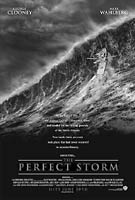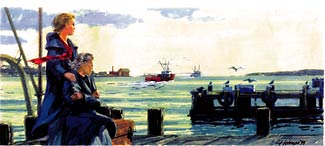FYIs: Jack Johnson won first place in the Paso Robles Art Association’s 1999 "Color of Autumn" show.
Jack Johnson exhibits his art in Michigan because he was raised in Indiana and spent his summer at an 1897 family cottage at Pier Cove on the shore of Lake Michigan.
The Perfect Set
A North County Artist Created Many of the Screen Scenes You’ve Seen
BY GRAHAM HAWORTH
A 50-foot wave is about to crash down on you and your boat. Alien spacecraft are attempting to blow up the world on Independence Day. A strange man with scissors for hands shows up in your suburban neighborhood. And finally, a sick and disgusting but hilarious ghoul is tormenting you and your wife after the two of you have died.
Sound like a sleepless evening full of nightmares? Fear not; these are just plot lines to some famous movies, but the exciting, eerie, and downright bizarre settings for "The Perfect Storm," "Independence Day," "Edward Scissorhands," and "Beetlejuice" all sprang from the mind of a man who could be your neighbor.
Major film illustrator and North County artist Jack Johnson was responsible for sketching and designing the sets for all these movies. He also worked on "The Shadow" and "The Hunt for Red October," and his current project is "Jurassic Park 3." And in his copious spare time, Johnson manages to turn out watercolor and oil paintings so rich in color and light that they almost look like photographs–but better.
almost look like photographs–but better.
Johnson’s official Hollywood title is "film illustrator." It’s his job to sketch and paint film sets before they’re built. He suggests the designs, colors, position, and scale of the sets as well as designing logos, themes, effects, and storyboards.
The 62-year-old Johnson started working in the movie business 22 years ago, when Hollywood was pulling in anyone off the street to work on movies. After 12 years in advertising, he couldn’t stand it anymore, so a friend in the movie biz urged him to change his line of work. At the time, film illustrators in Hollywood were using storyboards to sketch out set designs; storyboards are common in advertising as well, so Johnson was well-qualified for the Hollywood job.
These days, Johnson says, he doesn’t do many storyboards. He now sketches out sets in pencil or charcoal and paints the final designs in watercolors, oils, or gouache. He’s guided along the way by the director and the production designer. Johnson says sometimes he has a lot of freedom in designing sets, but other times the directors or production designers have concrete ideas of their own that they communicate to Johnson and he must interpret.
"Sometimes the artistic meetings can be very intense," says Johnson. "Other times, it’s very relaxed. It all depends on the director and the production designer and how close we are to shooting the movie."
For movies like "Edward Scissorhands," Johnson must come up with ideas for sets that are very surreal and dreamlike. What goes through his mind when he initially starts work on a project like "Edward Scissorhands"? For that movie, Tim Burton was the director, and Johnson says he enjoys working with Burton because he has a strong and unique design sense that pulls things together. He got a lot of his ideas for that movie from Burton and his production designer, Bo Welch.
After coming up with general ideas about the look of the movie, Johnson sits down and does what thousands of bored high school students across the nation do: He doodles.
"I sit down and sketch whatever comes to my mind," says Johnson. "I do a lot of doodling, and then I do a lot of research."
Research is one of the most important parts of Johnson’s job. In some of the initial paintings for "The Perfect Wave," his depictions of the Andrea Gail fishing vessel were not accurate because the research hadn’t been completed. Most people wouldn’t know the difference, but insiders and experts would and Johnson is a stickler for accuracy.
For example, in "Edward Scissorhands" there’s a castle on a hill that’s surrounded by topiaries. Johnson did hours of research on English and Old World gardens to make sure his sketches were realistic.
"When you do lots of research, you’re bound to come across something that inspires you," says Johnson. "The other side of research is make-believe."
Of the movies he’s worked on, Johnson’s favorites take place in a make-believe world, like "Toys" with Robin Williams, which was Johnson’s most favorite. This fantasyland enables Johnson to get very creative. He says he gets tired of sketching out car chases and everyday bedrooms and living rooms, especially considering the amount of sketching, drawing, and painting involved with one film.
Take, for example, one of Johnson’s latest projects. For "The Perfect Storm" Johnson turned out more than 70 paintings and another 15 to 20 sketches. Add to that the many 3-by-1-inch thumbnail sketches he does beforehand to serve as a filming guide and you get some idea of the amount of work Johnson churns out for just one movie.
"It rarely gets boring, though," says Johnson. "All the sets are so different. For example, I’m working on ‘Jurassic Park 3’ right now, which is full of rain forests and dinosaurs. Before that, I worked on ‘Charlie’s Angels,’ which takes place in a big city."
For all the excitement, though, Johnson is growing tired of the rat race in Los Angeles. Right now, he rises from bed at 4:30 every morning to work on his own paintings before he goes to work in the movie business.
"I have to do my fine arts in the morning like that," says Johnson. "When I come home at night, I’m too exhausted to paint anything."
Johnson has been intrigued by the Central Coast since he drove through on Highway 1 some 40 years ago. Back then, Cambria was still an artists colony, and the idea of living there sounded good to Johnson. He just couldn’t afford it.
Things have changed. Two years ago, Johnson and his wife bought a 120-acre ranch off Highway 46 between Paso Robles and Cambria. They’ve been splitting their time between the ranch and Los Angeles, but once next spring rolls around, they hope to move to their ranch permanently so Johnson can focus his time on his painting.
Johnson paints mostly in watercolors and oils, while throwing in some gouache paintings every once in a while. He says he goes through periods when he’s painting with one or the other; he never paints with watercolors one day, then with oils the next.
"Working with watercolor and oil is difficult because they are opposites of each other," Johnson explains. "With watercolor, you have to go from light colors and then darken from there. You don’t have to worry about that with oil painting."
Johnson likes to paint with gouache, which has gum added to make it opaque, unlike watercolors, and mistakes are easier to fix. For that reason, Johnson often uses gouache to paint his thumbnail sketches for movie sets. One medium that Johnson refuses to paint with is acrylics.
"It’s like painting with a nail," says Johnson.
Despite the deadline pressure in designing movie sets, Johnson says it’s easier to design sets than it is to paint fine artworks. In set designing, there’s always a problem–but there’s always a solution, says Johnson. Things are pretty cut and dried as far as what needs to be painted and what the paintings should look like. Painting for himself is much harder.
"There’s a huge emotional difference between designing sets and painting," says Johnson. "Painting deals with lots of emotion and what you see at the time of the painting. When I paint a portrait of a child, I’m not painting just a portrait. I want to paint a child with personality who is involved in some part of their world."
Johnson’s main focus in his own painting is light and color. His "Suncatcher II" is a prime example of that focus. The silhouette of a young boy wading in the water with a net that looks like it’s catching the glare of the sunset in the water could be a metaphor for Johnson’s artistic goal.
"To establish light on objects is intriguing to me," says Johnson.
You can see some of Johnson’s work at the Aquarius Gallery in Cambria, where right now about six of Johnson’s pieces are hanging, and he says he’s sending more next month. There is no specific theme to the show; you’ll find everything from paintings of children to landscapes.
If you’re interested in seeing some of Johnson’s work from the movies, he is doing a show of movie sketches and paintings as well as his own personal work with the Paso Robles Art Association in November and December. Æ
Graham Haworth is a New Times intern who’s just waiting to be discovered by Hollywood.